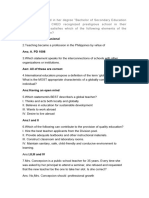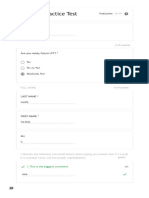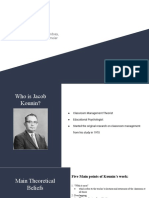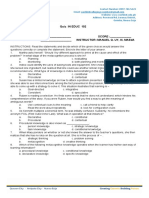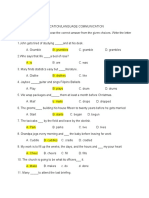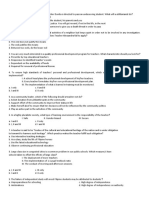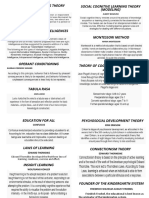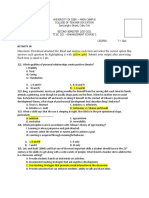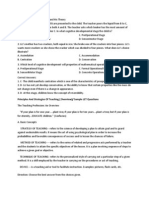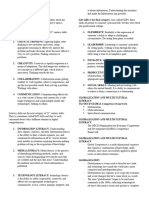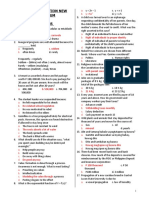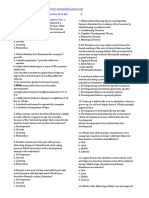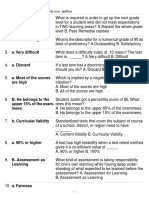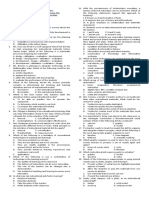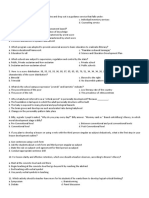SPED-CLASSROOM MANAGEMENT (FTRC) A.
Each child brings with him the beliefs
learned at home.
1. Diversity is popularly defined as B. Children with special needs have
A. differences between individuals. stereotype behaviors.
B. uniqueness in each individual. C. Special needs cases are different from
C. a group from different culture. one another.
D. developmental strengths and D. Children with special needs react
weaknesses. differently to sensory stimulations.
2. The clothes you wear and child-rearing 8. Your dialect can be a hindrance to learning
practices in the family is part of due to the fact that
A. culture. A. all dialects have inherently their own
B. socio-economic status. characteristics.
C. education. B. characteristics of dialects are seldom
D. language. found in the medium of instruction.
C. each dialect is distinct from one another.
3. Compliance behaviors are influenced D. many schools ban the use of dialects in
significantly by the way the campus.
A. adult and child interact.
B. the roles of boys and girls are perceived. 9. Which Philippine initiative strongly endorses
C. teachers teach the behavior. gender equality in schools?
D. child values himself. A. Eduacation Act of 1982
B. Salamanca Statement and Framework of
4. Typecasting household tasks as the female’s Action
responsibility is one way of reinforcing C. Republic Act 7277
A. cultural privileges. D. Education for All 2015
B. work orientation.
C. gender stereotypes. 10. The family is a key player in the education of
D. social responsibilities. the child especially in the
A. behavioral dimension.
5. The habit of greeting teachers and other B. instructional dimension.
adults may be a product of the home C. psychosocial dimension.
A. ritual. D. procedural dimension.
B. education.
C. interaction. 11. Teachers should always be on guard with
D. expectations. what they say and do since events in classroom
are
6. A student who always comes to school late A. varied and occur together.
may be bringing a kind of culture related to B. unpredictable and needs immediate
A. timeliness. attention.
B. work. C. multidimensional in nature.
C. educational goals. D. witnessed by a large portion of students.
D. child-adult interaction.
12. The psychological and social dynamics of
7. Which statement illustrates typical diversity in the class is a primary factor in establishing the
a special education classroom? classroom
1
� A. discipline. 18. What management component is the
B. procedures. common cause of teacher burn-out?
C. interpersonal relationship. A. psychosocial dimension.
D. climate. B. procedural dimension.
C. behavioral dimension.
D. organizational dimension.
13. Teachers should have “eyes at the back of
their heads” because the classroom has an
element of 19. Brigada Eskwela is a program that focuses
A. unpredictability. on the
B. multidimensionality. A. procedural dimension.
C. simultaneity. B. psychosocial dimension.
D. surprise. C. behavioral dimension.
D. physical dimension.
14. Ms. Cruz seems to be bothered by the
noncompliance of rules and procedures in her 20. The purpose of support instructional
class. It is necessary that she reviews the materials is to
component on ________ dimension. A. teach the new lesson.
A. psychosocial B. enhance learning.
B. instructional C. replace teacher’s functions.
C. behavioral D. make learning faster.
D. Procedural
21. Which is a criticism of two-dimensional
15. When unnecessary noise peaks while the materials?
lesson is going on, we can assume that there is A. They are found everywhere.
something wrong with B. They are beyond the reach of teachers.
A. physical dimension. C. They require complex skills in using.
B. organizational dimension. D. They provide only visual experiences.
C. procedural dimension.
D. instructional dimension. 22. An aid in presenting large two-dimension
materials is hung on the wall is the
16. A component in classroom management that A. flip chart.
can be a critical factor in relationships between B. pocket chart.
school personnel is C. diorama.
A. behavioral dimension. D. overhead projector.
B. psychosocial dimension.
C. procedural dimension. 23. If it is not safe or practical to use real objects
D. organizational dimension. like a knife and a house in the classroom, the
best alternative to use are
17. Teachers should learn to be decisive as a A. pictures.
response to B. realias.
A. immediacy of classroom events. C. photographers.
B. publicness of classroom behaviors. D. photos.
C. simultaneity of classroom activities.
D. unpredictability of classroom events. 24. A series of pictures arranged to represent a
schedule for the day for a child is a form of
2
� A. two-dimensional material. A. Request the class to sit down to watch
B. assistive technology. silently.
C. three-dimensional material. B. Tell the class to sing along with the
D. model. performers.
C. Preview the video clip before using it in
25. Pictures with minimal details are effective for class.
children who have D. Schedule a time for showing.
A. high intellectual abilities.
B. attention deficits. 30. A type of classroom time that includes
C. creative and artistic talents. administrative and organizational tasks is
D. speech disorders. A. instructional.
B. allocated.
26. A support instructional material has C. non-instructional.
meaningfulness if it is characterized as D. wasted.
A. flexible in purpose.
B. age appropriate. 31. A teacher starts the day reminding children
C. sensitive to cultural issues. of the classroom rules and picking out students
D. available at the time of use. who were demonstrating inappropriate
behaviors. This situation refers to
27. Graphs can be distinguished from charts as A. engagement time.
the latter depicts B. non-instructional time.
A. measurable data. C. time on-task.
B. diagrams and verbal information. D. wasted time.
C. lines and dots.
D. numerical information. 32. The practice of taking attendance or
collecting fees and contributions during class
28. Ms. Penny showed a picture to a group of time is considered
learners assessed with problem behaviors. Upon A. non-instructional time.
seeing the picture the class became noisy – B. wasted time.
some pointing to the picture and laughing, some C. allocated time.
stood up and went around to the other seats, D. instructional time.
some talked with a seatmate. As a whole, the
class became chaotic. What assumption can you 33. A mother complains that her son was not
infer tor this kind of reaction? able to eat snacks because he was made to
A. The picture has many irrelevant cues complete his writing task during recess time. As
serving as distracters. the principal of the school, you should look into
B. The picture is small and not clear to A. management of task engagement.
everyone. B. class schedule.
C. The picture has a balance between cool C. management of behavior.
and warm colors. D. teacher behavior.
D. The picture is only one unit (single
object) in the picture. 34. Ms. Santos always stops her lesson
whenever she notices a student demonstrating
29. It is the first time Ms. Meg would use a an inappropriate behavior. After reprimanding
compact disc to teach an action song. What the student for a minute or two she returns to the
would she do first?
3
�previous lesson. What effect will Ms. Santos’ 40. Which is the “ripple effect” of transition?
behavior have on her students? A. Change in the behavior patterns and
A. The students will learn to behave in her routines of individuals working with the
class. child.
B. Inappropriate behaviors will increase. B. Improvement of the educational system
C. Students will disengage in the lesson. serving the needs of CSN’s.
D. The class will demonstrate active C. Teachers intensive training in special
participation. education.
D. The community changing its culture.
35. In planning for transition, the transition team
should always be guided by the principle of 41. Successful transition programs for the
A. normalization. special needs population should focus on
B. fairness. A. process.
C. respect. B. outcomes.
D. freedom. C. strategies.
D. procedures.
36. What will make the change of one activity to 42. In preparing the child for transition to another
another most difficult among children with autism program, the first step to do is
is their need for A. identify the possible receiving program.
A. love. B. visit the possible receiving agencies.
B. social peers. C. look at the record of the child if he is
C. sameness. ready.
D. activity. D. form a transition team.
37. During transition time, inefficient classroom 43. On Saturdays Ms. Jane brings Arnold to
managers experience increased different centers producing crafts and other
A. disruptive behaviors. products from recyclable materials. Arnold has
B. focus on the activity. global developmental delay and is partially
C. compliance on the part of the students. mainstreamed in second year high school. At 17,
D. utilization of non-instructional time. Ms. Jane believes that Arnold is ready for
transition to community living. What approach
38. Gifted learners experience anxiety and a does Ms. Jane use?
feeling of vulnerability in transit to a new A. Role playing
program due to their B. Simulation
A. abundance of intellectual and social gifts. C. Information sharing
B. many interests. D. Visits to workplaces
C. heightened sensitivity.
D. intense motivation. 44. Mary’s mother always reminds her teacher to
exempt Mary from Physical Education activities
39. The invisible nature of mild disabilities may or housekeeping work in the classroom due to
cause problems in the asthma. But Mary loves to sweep the floor or
A. educational settings. arrange the books on the shelf. The teacher has
B. social and recreational settings. observed that when she does these, there are
C. home and family environment. no signs of asthma attacks. The mother’s reason
D. work environment. exemplifies a barrier which is
A. the culture bias toward exceptionality.
4
� B. practices valued at home. Situation: The teacher saw Pete, an 8-year old
C. the disability itself. Grade 2 pupil, getting money from his
D. indulgence as a gift of God. classmate’s bag when everybody was out of
recess. When asked about his action, he replied,
45. A typical problem behavior can become a “It’s my money and he (owner of the bag) told
disruptive behavior disorder if it becomes me to get it.” when the children came in the
A. a combination of one or more problem room after recess time, the owner of the bag
behaviors. reported that he lost his money.
B. persistent, frequent, and intense. 49. If you were the teacher, what is the best
C. disturbing to the environment and impairs thing to do?
the social, academic and occupational A. Ignore the incident.
function of the individual. B. Announce to the class that you saw Pete
D. a pattern of behavior of the individual. get the money.
C. Warn the class never to leave their
46. There is difficulty in coming up with only one money in the room during recess time.
definition of problem behavior because it is D. Tell the owner you will deal with the
__________. problem immediately after the lesson.
A. situation-specific.
B. based on the uniqueness of the 50. What is the right thing to do for children who
individuals. displays attention seeking behavior?
C. common to everybody. A. Tell them not to hurt others.
D. a part of daily life. B. Give them time to change their behavior,
they will just outgrow it.
47. The study of problem behaviors is also a C. Provide immediate acknowledgement of
study of acceptable behavior displayed.
A. classroom management. D. Ignore them including their behavior.
B. adjustment difficulties.
C. personality. 51. The behaviors that schools expect all
D. behavior management. students to know and do are called
A. rules.
Situation: The teacher saw Pete, an 8-year old B. standards.
Grade 2 pupil, getting money from his C. procedures.
classmate’s bag when everybody was out of D. routines.
recess. When asked about his action, he replied,
“It’s my money and he (owner of the bag) told 52. What is the basic characteristic of rules?
me to get it.” when the children came in the A. Rules are not negotiable.
room after recess time, the owner of the bag B. Rules can change from day to day
reported that he lost his money. according to the need.
48. Assuming that Pete was the culprit, what is C. Rules tell “how to” of the behavior.
the problem behavior of Pete? D. Rules help in the smooth operation of the
A. Impulsivity lesson.
B. Conduct disorder
C. Oppositional defiant disorder 53. Aside from health and safety, well-defined
D. Talking out rules in special education help
A. increase appropriate behavior.
B. hasten the normalization of the learner.
5
� C. catch students behaving inappropriately. 59. Which is an acceptable rule for preventing
D. maximizes on-task behavior. aggressive behavior among children with
ADHD?
54. When a student violates a rule, it is assumed A. Kicking is bad.
that the student B. Be kind to others.
A. is testing the limits of the school C. Don’t hurt others.
authority. D. Respect others.
B. does not know that the rule exists.
C. has no behavior for it. 60. Jan seems to have a record of rule violations
D. believes that the rule is not meaningful in school. If you were Jan’s teacher, what is the
for him. best thing to do?
A. Teach Jan the behavior needed for the
55. A method of teaching where the behavior is rules.
broken into smaller tasks and taught by steps is B. Administer punishment when Jan
A. fading. violates a rule.
B. modelling. C. Ignore Jan’s violations; they are too
C. demonstration. many for the teacher to handle.
D. shaping. D. Advise Jan to see a psychiatrist.
56. Which is a primary reminder in order to have 61. You can only be considered a professional
a smooth transition from one activity to another? teacher if you have
A. Vary the activities frequently. A. Bachelor’s degree in a field of
B. Establish routine for ending the activity specialization.
and beginning a new one. B. competencies in your assigned area.
C. Ring the bell to signal the end of an C. passed the Licensure Examination for
activity. Teachers.
D. Select only students who are ready to D. gained membership in accredited
change activity. organizations.
57. A class posted a rule on their blackboard 62. Teacher are important variables in the life of
that says “No shouting inside the classroom.” students since
what principle in making rules was violated? A. good teachers are models of behaviors.
A. Rules must be simply worded. B. teachers have the first and last say in
B. Rules must be in the language the school.
students can understand. C. students believe in what they say and do.
C. Rules must be stated in positive terms. D. the kind of school experiences of
D. Enforcement of rules is easier when they students depend on teachers.
are made by the students.
63. Students who are always in conflict with the
58. Which is a visual prompt? rules of the school need teachers who are
A. Hand over hand A. patient and caring.
B. Proximity of teacher to child B. influential and authoritative.
C. Requesting the child to sit down C. endowed with a sense of humor.
D. Hand over shoulder D. threatening and punitive.
6
�64. A safe and secured learning environment B. introduce progress and reform.
can be attained if the teacher is C. develop skills and teaching.
A. firm and strict. D. establish association between practice
B. laissez faire. and outcome.
C. democratic.
D. autocratic and punitive. 70. When a teacher is certain that the approach
he or she is using has been validated through a
65. Humdrum moments in the classroom usually research process it can create a feeling of
occur during A. worth.
A. change from one activity to another. B. self-esteem.
B. manipulative activities. C. efficacy.
C. gaming sessions. D. efficiency.
D. “chalk-and-talk” lessons.
71. The major criticism of the traditional process-
66. As a curriculum planner, the Special outcome approach is its reliance on
Education teacher’s main responsibility is to A. statistics.
A. work with the team in preparing the B. enumeration data.
Individualized Education Plan for the C. researcher’s skills.
child. D. experimentation.
B. intervene inappropriate behaviors.
C. share knowledge about children with 72. The improvement on the process-outcome
special needs with the General Education approach in classroom management research is
teachers. indicated by
D. assist families in coping with their A. inclusion of interview and narrative
problems. recording data.
B. enhancing the skills of the researchers.
67. Teamwork with personnel for related C. utilization of statistical inferences.
services to the child is an indication of D. mastery in presenting results of studies.
A. instruction.
B. collaboration. 73. Which phase in the research activity is
C. research. comparable to your major responsibility as a
D. planning. Special Education teacher?
A. Identifying the problem
68. Which of these responsibilities is your B. Selecting the informants
primary consideration as a behavior manager? C. Collecting data
A. Intervene immediately when D. Reporting results
inappropriate behavior occurs.
B. Act decisively when behaviors are hurtful
to others.
C. Provide a model to address emotional
and behavioral needs.
D. Maintain a trusting, open and equal
relationship with each child.
69. The ultimate goal of educational research is
A. change the system.
7
